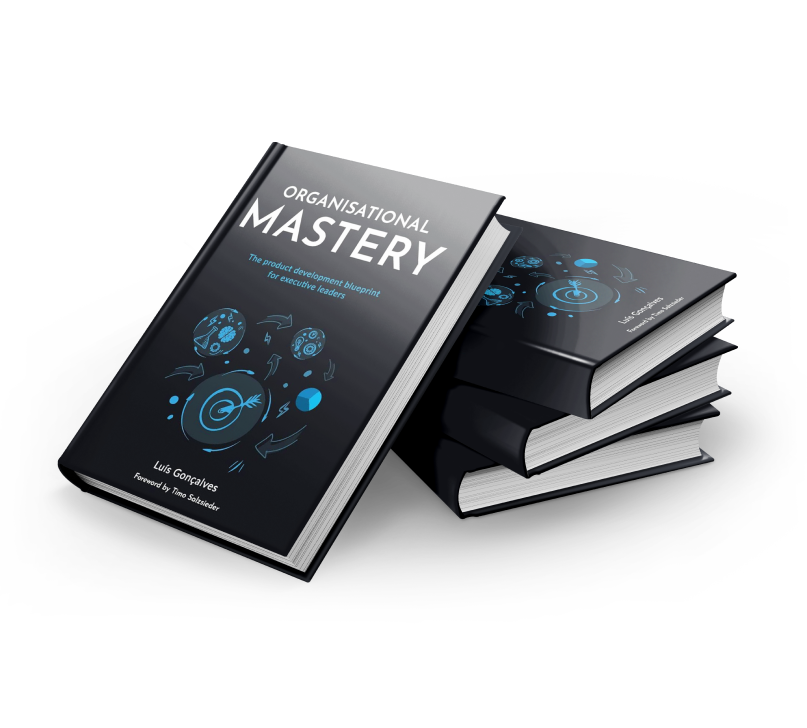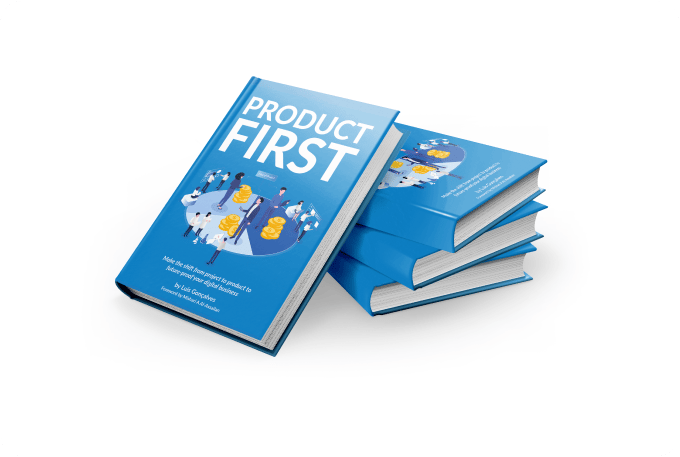Share this
Product Time to Market, The Complete Guide
by Luis Gonçalves on Jan 13, 2024 6:12:07 AM
The speed at which a product reaches its intended market is a crucial determinant of its ultimate success, this concept, referred to as "Product Time to Market", can significantly impact your organization's competitive positioning, profitability, and customer satisfaction levels.
It's especially vital in the context of project to product transformations, where streamlining processes and ensuring timely delivery can make all the difference.
In today's blog post, we will explore the multifaceted concept of Product Time to Market. We'll delve into its importance, the factors influencing it, and how it can be optimized for better outcomes in your project to product transformation journey.
Product Time to Market isn't just about speeding up production; it involves strategically aligning all the stages of product development—from concept to launch—to create a cohesive, efficient, and productive timeline.
Understanding how to navigate and manage these phases is key to accelerating your product's journey to the market and gaining a competitive edge.
Whether you are a product manager, project leader, or executive overseeing a project to product transformation, understanding Product Time to Market can greatly influence your strategic decisions, help you manage risks effectively, and most importantly, ensure that your products reach the market at the right time.
Let's dive deeper into this topic to discover how we can leverage time as a competitive advantage in the race to market.
Society changed and leaders need support in the way how they lead and design their digital product organizations, that is the reason why the ADAPT Methodology® was created, but now let’s get a deep dive into the Product Time To Market.
A delay in the commercialization of a product can be a deal-breaker. This is because the novelty of a new product or feature quickly diminishes. So what can your company do to ensure that your innovations reach consumers quickly? Understanding the concept of Product Time to Market is an excellent initial step for any Digital Product Company leader.
Understanding Product Time to Market and Its Importance
Product Time to Market (TTM) is the duration needed to bring a product to fruition. This includes the generation of an idea for the product; its whole design cycle; development, and launch on the market.
The more streamlined and effective your company's product development process is, the better you will be able to predict its product time to market. It can also assist you in making plans on how to roll out the product at the right place and time.
Also known as Speed to Market (STM), the concept is the prime determining factor in the success of innovation for several reasons. First of all, your competitors are all investing in innovations to varying degrees.
Delaying monetizing your improvements or ideas gives them the chance to pull ahead of you in the market. Next, the majority of innovations are technology dependent or enabled.
Bear in mind that technology changes at a dizzying pace and a delay could render your ideas redundant. Lastly, the life cycle for optimal pricing for your product or innovation shrinks day by day. Once it has become mainstream, your product would not yield high incremental returns.
The Importance of Product Time to Market
Reducing product time to market is essential for businesses for several reasons:
- Gaining a Competitive Edge: Bringing a product to market faster than competitors can provide a significant advantage, as it allows a company to capture market share and customer mindshare early on.
- Early Revenue Generation: A faster time to market means that companies can start generating revenue from their products sooner, which can help to recoup the costs of product development and fuel further innovation.
- Maximizing Product Lifecycle: A shorter time to market enables companies to capitalize on the full potential of a product's lifecycle, by making the most of early adopter enthusiasm and capturing a larger share of the market.
- Brand Reputation: Releasing products in a timely manner can enhance a company's reputation for innovation and responsiveness to customer needs, which can help to build brand loyalty and drive long-term growth.
Factors Affecting Product Time to Market
Several factors can impact a product's time to market, including:
- Product Complexity: More complex products typically require longer development times, as they involve a greater number of components, processes, and potential challenges.
- Supply Chain Management: Efficient supply chain management is crucial for reducing time to market, as it ensures that the necessary materials, components, and resources are available when needed.
- Regulatory Requirements: Meeting regulatory standards and obtaining necessary approvals can be time-consuming, depending on the industry and product type.
- Resource Availability: The availability of skilled personnel, sufficient funding, and appropriate technology can all affect the time it takes to bring a product to market.
Benefits of Improving Product Time to Market for Your Company
The product Time to market remains at play regardless of whether you are using the resource efficiency or flow efficiency method. After all, the goal is to improve the company's time to market.
The duration of your Product's Time to Market can have a severe negative impact on your business. These days, organizations and product design teams misuse more than 40% of their resources, which leads to inefficiency and delays.
Most of this waste is due to meaningless overhead, like administrative paperwork, boring and repetitive work, unnecessary features, poor product launches, and shoddy information management.
What's more, 80% of these data (emails, photos, videos, and social media) are disorganized and unstructured while tools do not provide adequate support.
However, speeding your company's time to market provides immediate benefits, like:
- Efficient Managerial Processes: Developing a reliable timeline allows your core team to get ahead of the production cost and time, and screate schedules based on lead time and headcount planning.
- Boost Margin Revenue: The more aware or in touch your company is with what the market needs, without compromising quality, the higher your revenue will be since you can release your product earlier than expected and meet market needs.
- Higher Market Shares: Being able to speed up TTM will give your business an edge over your competitors. Releasing your innovations ahead of the pack will also help you corner higher market shares.
- Keeps You Ahead of the Competition: An optimized speed to market will keep you ahead of your competitors and give you the chance to maximize the latest technology. This will also help open more market opportunities for you and your product.
Fundamental Pillars To Improve Product Time to Market
Resource Efficiency or Flow Efficiency?
For a company to work well and efficiently to come up with the right innovations, they have to choose what the right work system is for them. Do they focus on resource efficiency or flow efficiency?
In resource efficiency, workflows from one individual to another. Every individual here is considered a specialist, which means they are the only ones who can do the job. While each person is optimized and fully utilized when using a resource-efficient system, the feature is only accomplished when the specialist gets to it.
Meanwhile, flow efficiency focuses on the team. The whole group specializes in a particular feature area. This means that when one is unavailable, the team can still work. The work might be a little slower since members have more or less the same level of specialization, but it is guaranteed that they can release the features.
Both approaches have their pros and cons. While resource efficiency focuses on optimizing the individual, flow efficiency optimizes the feature. The former can lead to work queues piling up behind the specialist in charge of a feature while the others wait.
The rest of the team will probably start on other features that they can, resulting in multitasking. It can also lead to feeling pressure as the deadline looms nearer but the main features are not finished yet.
It is the opposite of flow efficiency. Since everyone on the team works together, everybody also finishes things together. For instance, while one member works on the UI, another can start creating automated tests that are not dependent on the UI being developed. A sense of accomplishment will be felt as progress is made slowly but surely.
Agile Methodologies
In the pursuit of minimizing Time to Market (TTM), the adoption of Agile Methodologies stands out as a mandatory pillar, orchestrating a symphony of adaptability, continuous improvement, and customer-centricity in the product development journey.
Agile, with its inherent flexibility and iterative nature, enables organizations to navigate through the complexities and volatilities of the market with dexterity and foresight. It facilitates a nimble development environment where changes can be seamlessly integrated, and customer feedback is not only welcomed but becomes a driving force for enhancement and innovation.
Agile Methodologies such as Scrum, foster a collaborative and transparent workspace, ensuring that every stakeholder, from developers to customers, is in synchrony with the product’s journey, thereby reducing bottlenecks, enhancing efficiency, and ensuring that the final product is finely tuned to market demands.
The iterative cycles of Agile allow for continuous refinement, ensuring that the product evolves with each sprint, mitigating the risks of market misalignment, and ensuring that when the product does hit the market, it is not just timely but also resonates with the expectations and needs of the consumers.
Thus, Agile methodologies are not merely a structural approach to product development but a strategic enabler of reduced TTM, ensuring that products are developed in a manner that is both, rapid and reflective of market needs.
Technical Excellency and Continuous Pipelines
In the intricate and fast-paced world of product development, Technical excellence and the implementation of Continuous Pipelines emerge as mandatory pillars, critically influencing reductions in Time to Market (TTM).
Technical Excellency, which encompasses robust, scalable, and efficient technological practices, ensures that the product development journey is smooth, resilient, and free from technical debt that could impede the speed of delivery.
On the other hand, Continuous Pipelines, which involve seamless integration and delivery mechanisms, ensure that the product evolves and adapts in a streamlined manner from development through to deployment, maintaining a consistent and rapid flow toward market release.
The amalgamation of Technical excellence and Continuous Pipelines ensures that the product is not only developed on a technologically sound foundation but also progresses toward the market through a pathway that is uninterrupted and consistently forward-moving.
This dual pillar not only mitigates the risks of delays and roadblocks in the development cycle but also ensures that the product, when it reaches the market, is of optimal quality, functionality, and reliability.
Thus, Technical Excellency and Continuous Pipelines transition from being mere practices to becoming strategic enablers, ensuring that the product’s journey to the market is as swift as it is smooth and reliable.
Creating Product Value Streams
In the strategic transition from project to product, establishing Product Value Streams emerges as a mandatory pillar, significantly curtailing Time to Market (TTM) and enhancing organizational agility.
Unlike matrix organizations, where resources are often entangled in a web of conflicting priorities and divided attention, Product Value Streams focus on delivering end-to-end value through a product-oriented approach. This methodology aligns cross-functional teams under a unified product vision, ensuring that every effort, from conception to delivery, is cohesively directed toward creating and enhancing product value.
By dismantling silos and fostering a collaborative environment where teams are dedicated to specific product outcomes, Product Value Streams ensure that the journey from ideation to market is not hindered by organizational complexities or misaligned objectives.
This approach not only accelerates product development by ensuring that every resource is unequivocally focused on delivering product value but also enhances the quality and innovation of the product by facilitating continuous feedback and improvement within the dedicated value stream.
Therefore, Product Value Streams become not merely a structural approach but a strategic enabler, ensuring that the pathway to the market is direct, undistracted, and relentlessly focused on delivering unparalleled product value.
Lean Budgeting and Assigning Budget to Value Streams
In the pursuit of reducing Time to Market (TTM) and enhancing product value, Lean Budgeting and Assigning Budget to Value Streams stand out as pivotal pillars, weaving financial prudence with strategic allocation to expedite product delivery.
Lean Budgeting, rooted in the principles of maximizing value and minimizing waste, ensures that every financial resource is judiciously utilized, eliminating frivolous expenditures and focusing on aspects that directly contribute to product development and enhancement.
On the other hand, Assigning Budget to Value Streams ensures that financial resources are directly channeled into pathways that create and enhance product value from conception to delivery. This strategic allocation of budget to specific value streams not only ensures that the financial resources are utilized in the most impactful manner but also ensures that the product development process is not hampered by financial constraints or diversions.
By ensuring that the budget is lean, focused, and strategically aligned with value creation and delivery, organizations ensure that the product moves through the development cycle in a manner that is financially sustainable, strategically sound, and aligned with the overarching objective of reducing TTM.
Thus, Lean Budgeting and Assigning Budgets to Value Streams emerge as not just financial strategies but as strategic enablers, ensuring that the journey from project to product is financially optimized and strategically aligned with organizational objectives.
OKRs
In the realm of swift and efficient product development, OKRs (Objectives and Key Results) emerge as a mandatory pillar, instrumental in reducing Time to Market (TTM) by aligning every individual’s efforts towards unified organizational goals.
OKRs, by defining clear, measurable objectives and tracing a path through quantifiable key results, create a structured framework that ensures every team member is not only aware of the end goals but is also consistently working towards them. This methodology ensures that the collective organizational effort is laser-focused on achieving specific outcomes, thereby eliminating divergent efforts and ensuring that every action taken is a step toward the desired objective.
The clarity provided by OKRs ensures that teams are not working in silos with disparate goals, but are harmoniously working towards common objectives, thereby significantly reducing the likelihood of delays caused by misaligned efforts or priorities.
Furthermore, by providing a clear sight of the objectives and a measurable pathway to achieve them, OKRs ensure that the product development process is not only accelerated but is also strategically aligned with organizational goals and market demands.
Thus, OKRs transition from being a goal-setting framework to a strategic accelerator in the product development journey, ensuring that every effort is concerted, every action is aligned, and every step taken collectively reduces the time to market.
Cost of Delay
Navigating through the intricate pathways of product development, the Cost of Delay (CoD) emerges as a mandatory pillar, critically influencing strategies aimed at reducing Time to Market (TTM).
CoD, defined as the economic impact of the time taken to bring a product to market, becomes a pivotal metric that quantifies the financial implications of delays, thereby providing a tangible measure that underscores the urgency of swift product delivery.
It encapsulates the potential revenues, market share, and competitive advantages lost during the development cycle, translating them into discernible financial terms. By meticulously analyzing and understanding CoD, organizations can strategically prioritize features, projects, and initiatives that align with maximizing economic value and minimizing potential financial losses associated with delays.
This approach not only ensures that development efforts are precisely targeted towards high-impact areas but also that they are executed with a keen awareness of the financial ramifications of time.
Thus, CoD doesn’t merely serve as a metric but as a strategic compass, guiding product development towards expedited pathways, ensuring that every moment spent in the product lifecycle is economically justified, and that the journey from project to product is both, swift and financially optimized.
The Organizational Impediment Board
In the strategic endeavor to minimize Time to Market (TTM), the establishment and utilization of an Organizational Impediment Board become paramount, acting as a crucial pillar that underpins the seamless transition from project inception to product delivery.
This board, essentially a structured platform, meticulously identifies, assesses, and addresses impediments that could potentially hinder the product development process, thereby ensuring that the pathway to market is as unobstructed and efficient as possible.
It serves as a centralized mechanism to visualize, prioritize, and systematically eliminate obstacles, thereby safeguarding the product development cycle from unforeseen delays and quality issues.
By proactively addressing challenges and bottlenecks through the Organizational Impediment Board, companies ensure that every phase of the product journey, from conceptualization to deployment, is optimized and expedited.
This not only ensures that products reach the market swiftly but also that they adhere to the highest standards of quality and functionality, as potential issues are addressed before they can escalate into significant roadblocks.
Thus, the Organizational Impediment Board is not merely a problem-solving entity but a strategic facilitator of reduced TTM, ensuring that products are not only developed efficiently but are also robust, high-quality, and precisely aligned with market and customer demands.
Communities of Practice
In the intricate journey from project initiation to product delivery, Communities of Practice (CoP) stand out as a mandatory pillar, significantly enhancing the Time to Market (TTM) reductions by fostering a rich environment for knowledge sharing and collective learning.
Communities of Practice, which are groups where individuals with shared interests or professions collaboratively navigate through challenges, innovations, and solutions, become a powerhouse of collective intelligence and a catalyst for innovation in product development.
By facilitating a platform where knowledge is not siloed but freely exchanged, Communities of Practice ensures that insights, learnings, and solutions are rapidly disseminated throughout the organization, thereby reducing the learning curve and accelerating problem-solving across teams.
This collective wisdom not only aids in swiftly navigating through challenges but also in preemptively identifying and mitigating potential roadblocks in the product development journey.
Moreover, Communities of Practice enhances the organizational capability to innovate, optimize processes, and enhance product quality by leveraging collective expertise and experiences, thereby ensuring that the product not only reaches the market swiftly but is also of superior quality and innovation.
Thus, Communities of Practice transcend from being mere knowledge-sharing forums to becoming strategic accelerators in reducing TTM, ensuring that the pathway from conception to market is both, expedited and enriched with collective organizational wisdom.
Product Discovery To Reduce Product Time to Market
Navigating the pathway from Product Discovery to releasing a product that genuinely resonates with the market is an indispensable pillar in slashing Time to Market (TTM) and ensuring the product’s success.
Product Discovery, which involves a meticulous process of understanding customer needs, market demands, and potential product features, ensures that the product developed is not just innovative but also precisely aligns with what the market desires.
This phase is crucial in avoiding missteps that could lead to developing features or products that are misaligned with market needs, thereby saving both time and resources.
By ensuring that product development is guided by a thorough understanding of the market, organizations ensure that every step taken in the product development journey is purposeful and directly contributes to creating a product that the market eagerly anticipates. This strategic alignment of product development with market needs ensures that the product, upon release, is immediately relevant, thereby reducing TTM by avoiding iterations and modifications post-launch.
Thus, Product Discovery to releasing market-aligned products becomes not just a development strategy but a pivotal pillar ensuring that the product’s journey from conception to market is direct, relevant, and expedient.
Conclusion
A company's capacity to reduce its product Time to Market for innovations is the key differential when it comes to success. A speedy TTM will ensure that your product is out to consumers as soon as possible. This will give you an edge over competitors.
Consider carefully whether you should focus on making your resources or your workflow more efficient. This will have a significant impact on how effectively and efficiently your innovation investments will be managed.
Did you like this article?
We enable leaders to become highly valued and recognized to make an impact on the World by helping them to design Digital Product Companies that will thrive and nourish in the Digital Age, we do this by applying our own ADAPT Methodology®.
If you are interested in knowing if you have what it takes to design and build a great digital product company simply take our Digital Leadership Influence Scorecard.
If you want to know how we can help you to start your transformation please check out our: Training.
If you are interested in doing a transformation in your company please check out our: Consulting.
Share this
- Agile Methodologies (18)
- Product Strategy (18)
- OKRs (16)
- Scrum (16)
- Product Mindset (14)
- Project To Product (10)
- Agile Retrospectives (9)
- CoPs (9)
- Knowledge Sharing (9)
- Time To Market (8)
- Product Discovery (7)
- Continuous Improvement (5)
- Strategy (5)
- Scrum Master (4)
- Content Marketing Strategy (3)
- Product Owner (3)
- Technical Excellency (3)
- Digital Transformation (2)
- Innovation (2)
- Scaling (2)
- Team Building (2)
- Business Model (1)
- Cost Of Delay (1)
- Customer Feedback (1)
- Customer Journey (1)
- Customer Personas (1)
- Design Thinking (1)
- Digital Leadership (1)
- Digital Product Tools (1)
- Go To Market Strategy (1)
- Google Design Sprint (1)
- Lean Budgeting (1)
- Lean Change Management (1)
- Market Solution Fit (1)
- Organisational Impediments (1)
- Outsourcing (1)
- Product (1)
- Product Metrics (1)
- Product Roadmaps (1)

Organisational Mastery
Get your free copy

ADAPT
Get your free copy

Product First
Get your free copy


